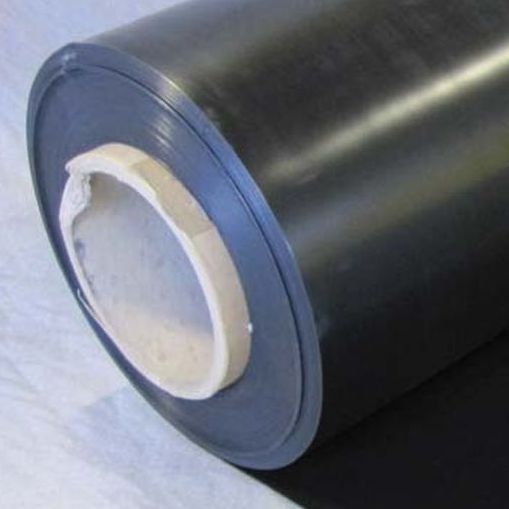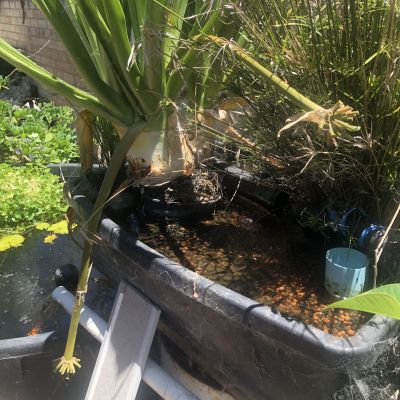Introduction to Geomembranes:
Geomembrane materials are produced using various resins, processing agents, UV stabilizers, pigments, and fillers. The resulting sheets are designed to be cost-effective, durable, and easy to install. However, not all materials are created equal, so it’s important to carefully assess each option before specifying one for a particular application. Two commonly used geomembranes in exposed conditions are EPDM (Ethylene Propylene Diene Monomer) rubber and HDPE (High-Density Polyethylene). Below is an overview comparing these two materials based on key factors such as durability, design, and suitability for different uses.
Durability and Longevity
Oase EasyFol EPDM is a synthetic rubber designed to withstand extended outdoor exposure, as well as the effects of environments containing microorganisms. When installed according to manufacturer specifications, it is backed by a 20-year warranty. Oase EasyFol EPDM follows a consistent production process, ensuring reliable quality control.
HDPE, a semicrystalline thermoplastic, is also engineered for exposed conditions. However, its structure makes it prone to premature cracking, particularly stress cracking at weld seams that experience high thermal stress. This form of failure occurs in a brittle manner, showing little to no elongation near the failure point. Additionally, since HDPE manufacturers frequently alter their production processes to reduce costs, this can lead to inconsistent weld quality and material variations.
Performance in Cold Environments
Oase EasyFol EPDM is highly resistant to low temperatures, retaining its flexibility even in extreme conditions. It can be installed and seamed at temperatures as low as -45°C, making it suitable for northern climates.
While HDPE has been used in cold environments, it requires installation above 37°C ambient temperature due to its stiffness in cold weather. The material is also vulnerable to brittleness, particularly at the seams, and its tendency to expand and contract excessively can cause it to tighten, leading to stress on the material.
Toughness and Adaptability
At a thickness of 1.14 mm, Oase EasyFol EPDM can stretch over 300% of its original length, making it highly adaptable to irregular substrates without puncturing. Its rubber texture provides excellent friction, preventing soil from sliding off. As EPDM ages, its molecular structure tightens, increasing its strength but also leading to some shrinkage that needs to be accounted for in the design.
In contrast, HDPE has a low strain capacity, with a yield point of only 15%. Its rigidity prevents it from conforming to rough surfaces, and it tends to “bridge” over uneven areas. The smooth surface of HDPE also results in minimal friction, which must be considered when placing it under or over soil materials.
Installation and Seaming
Oase EasyFol EPDM is supplied in wide rolls (up to 15 meters) that lay flat with minimal wrinkling. Seaming is straightforward, and contractors can use a patented splice tape system to achieve strong, water-tight seams. Visual inspection of seams is easy, though electrodes cannot be used to test the seams due to the high carbon content of the material.
HDPE rolls are typically up to 10 meters wide. Installation requires skilled workers using specialized thermal welding equipment. HDPE tends to wrinkle more significantly, especially with temperature fluctuations, and electrochemical testing can be used to check seam integrity.
Bonding to Concrete and Wood
Oase EasyFol EPDM can be easily bonded to concrete, wood, and block surfaces using either a solvent or water-based adhesive. The rubber’s texture helps ensure a strong bond to rough surfaces like concrete.
HDPE, however, does not naturally conform to concrete and is less suited for bonding with adhesives due to its rigidity and smooth surface.
Field Repair and Maintenance
Repairs on Oase EasyFol EPDM are simple and can be done by the owner using cover patches or tapes, even after years of outdoor exposure.
In contrast, HDPE repairs require specialized surface preparation and thermal welding by trained professionals, making them more costly and difficult to manage on-site.
Compatibility with Adjacent Materials
Oase EasyFol EPDM, with its durable rubber properties, is resistant to damage from large stones, blocks, and even fresh concrete. It is also fish-friendly and approved for potable water applications, making it a suitable choice for ponds and aquatic environments. Additionally, plant roots cannot penetrate EPDM, which is beneficial in aquatic settings.
HDPE requires extra protection, such as geotextiles or sand, to shield it from sharp or abrasive materials like rock and concrete. Textured HDPE sheets help prevent soil slippage but are more expensive and harder to install due to the increased complexity of welding.
Cost Comparison and Considerations
Although the upfront cost of Oase EasyFol EPDM may appear higher than HDPE (ranging from $10-11 per square meter, compared to HDPE’s $7.40 per square meter), the long-term benefits of EPDM—such as ease of installation, fewer maintenance requirements, and greater durability—can offer better value over time. HDPE, with its higher risk of stress cracking, requires specialized installation and additional protective materials, which can increase the overall cost of a project.
Conclusion
When choosing between Oase EasyFol EPDM and HDPE, the cost of the material should not be the sole deciding factor. While EPDM may come with a higher initial price, its superior durability, ease of installation, and long-term performance make it a more cost-effective choice for exposed geomembrane applications. Several other factors, including field repairability, compatibility with adjacent materials, and resistance to environmental stress, should also be considered in the decision-making process.
Comparison Table:
| Design Consideration | EPDM (1.14 mm) | HDPE (1.5 mm) |
|---|---|---|
| Sunlight Resistance | Excellent | Good |
| Stress Crack Resistance | Excellent | Fair |
| Cracking Resistance | Excellent | Fair |
| Heat Resistance | Good | Good |
| Thermal Expansion/Contraction | Good | Poor |
| Soil/Organic Environment Resistance | Excellent | Good |
| Ease of Installation | Excellent | Fair |
| Ease of Seaming | Excellent | Poor |
| Field Repair | Excellent | Poor |
| Low Temperature Flexibility | Excellent | Fair |
| Adhesive Bonding | Good | Poor |
| Long-Term Durability | Excellent | Fair |
| Average Cost (per m²) | $10-11 | $7.40 |
Rating Legend:
- Excellent: E
- Good: G
- Fair: F
- Poor: P
- Not Recommended: NR
This reworded comparison provides an original analysis of the differences between EPDM and HDPE geomembranes while avoiding plagiarism.
4o mini


